NINTH INTERNATIONAL
ORGAN AND EARLY MUSIC FESTIVAL
OAXACA, MEXICO
With a special focus on
COLONIAL ART IN THE CHURCHES OF OAXACA
FEBRUARY 15 - 20, 2012
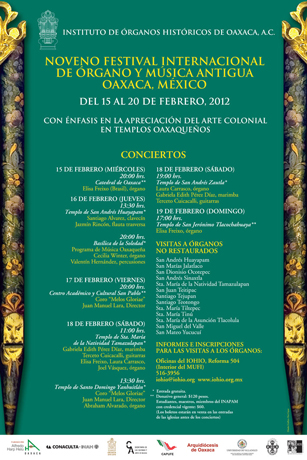
The Ninth Festival had barely finished before people were clamoring to know when the next one would be! Once again, the IOHIO offered a unique celebration of Oaxacan culture based on the historic pipe organs. Over the course of five and a half days participants could enjoy: concerts on six Oaxacan organs; two choral concerts in splendid colonial venues; one harpsichord and flute concert in a village church; visits to eleven unrestored organs with guided tours of their churches, many of which are usually inaccessible to the public; a guided tour of the archeological site of Monte Albán; a guided tour of the colonial churches of Oaxaca City; the opportunity for organists to play some of the organs; a presentation about the Oaxacan organs; an exhibit of manuscripts related to the organs from local archives; and a chance to savor the famous Oaxacan cuisine in three villages.
Our festival attracted more than 100 experts, students, and aficionados in fields related to organs, music, colonial art, and Oaxacan culture in general. The concerts were packed, and there were more local people in the audience than ever. Attendance was approximately: 260 people in the Cathedral; 150 in Huayapam, 380 in La Soledad, 230 in San Pablo, 150 in Tamazulapan, 150 in Yanhuitlán, 180 in Zautla, and 150 in Tlacochahuaya.
Our star performer was the internationally acclaimed Brazilian organist Elisa Freixo, who played the inaugural and final concerts. Twenty-five Mexican musicians were invited to participate as well: 4 organists, 14 singers, 3 guitarists, 2 percussionists (both Oaxacan), a flutist, and a harpsichordist, as well as a chorus of 14 singers. Also in attendance were 11 young Mexican organists and organ students from Guanajuato, Morelia, Mexico City, and Oaxaca. In addition to the musicians, we were honored to have with us Richard Perry, author of several books on Mexican colonial art, who guided the church tours.
February 15 (Wednesday)
The Festival began with the Inauguration of the Festival and reception in the Oaxaca Philatelic Museum (MUFI). María Isabel Grañen Porrúa, president of the Fundación Alfredo Harp Helú Oaxaca, and Eloy Pérez Sibaja, director of the Oaxaca Regional Center of the Instituto Nacional de Antropología e Historia (INAH), offered words of congratulations and the support of their respective institutions, after which Cicely Winter, director of the IOHIO, spoke about the goals of the festival.
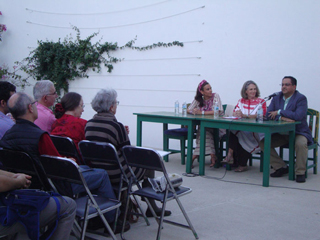 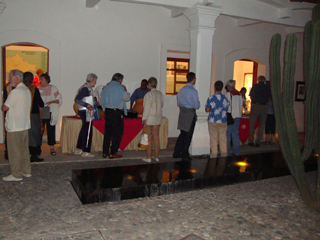
The First concert of the Festival took place in the Oaxaca Cathedral. Elisa Freixo offered a program of 16th – 18th century repertoire by composers of diverse nationalities, and her characteristic elegance of style set the high tone for the musical events to follow. Because of the position of the organ in the choir loft, the organist's back is to the audience, so the concert was projected onto a screen in the church. In this way it was possible to see how the registers are changed and watch Elisa's hands as she played. The monumental organ (1712) retains its opulently carved and gilded upper case, but its lower case has been rebuilt several times and there is no evidence of its original appearance. However, one can assume that it was once as richly decorated as the upper case.
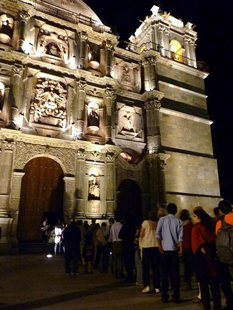 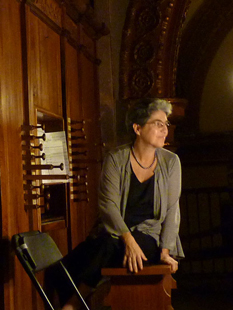
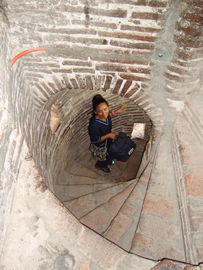
February 16 (Thursday)
The first full day of activities began with a visit to the church of San Matías Jalatlaco, located on the edge of the historic center of Oaxaca City. We ascended the first of the many winding stonestaircases we would encounter in the days ahead, in order to view the organ from the front in the choir loft. This elegantly proportioned blue 8´ (foot) organ was built in 1866 by the distinguished Mexican (Oaxacan?) organbuilder Pedro Nibra and was recently evaluated by organbuilder Gerhard Grenzing (Barcelona) for a possible future restoration.
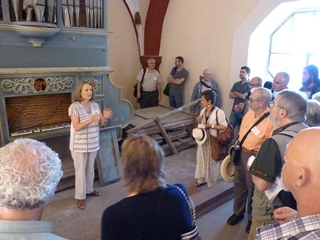
It is always interesting see how the group splits up when we entered a church, with the organbuilders scurrying up to the choir loft, the lovers of colonial art gravitating to the altarpieces (retablos), those with anthropological inclinations talking to the local people, and others just wandering around enjoying the overall experience.
Our next stop was in San Juan Teitipac, where Richard Perry and art historian Janet Esser offered an explanation of the famous 16th century Dominican mural at the entrance of the former convent.
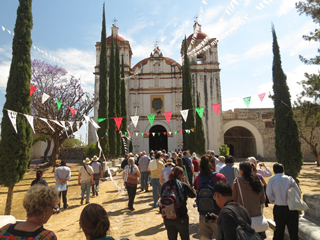 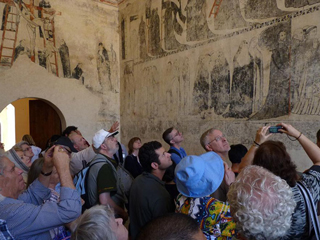
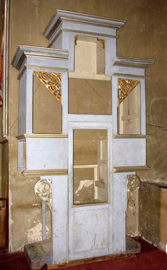
Inside the baroque style church, we viewed the empty 18th -century organ case which was painted light blue and converted into a confessional in the 1970s. It was later abandoned in a storeroom where the IOHIO found it some years ago and moved it back into the church.
We proceeded to the church of San Jerónimo Tlacochahuaya, considered to be one of the loveliest in Mexico with its exuberant interior floral decoration and exquisite baroque altarpieces, all recently restored. The focus of the visit was the church art rather than the organ, since there wouldn’t be time to view it calmly after the upcoming concert on Sunday.
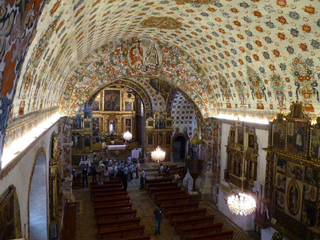 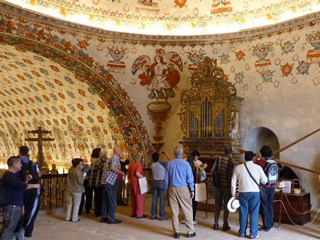
Mexico City artists Santiago Alvarez (harpsichord) and Jazmín Rincón (baroque flute) presented the Second concert of the Festival, entitled “A musical voyage through 18th century Europe,” in San Andrés Huayapam on the outskirts of Oaxaca City. Their delightful program was enhanced by the main altarpiece behind them, one of the most beautiful in Oaxaca, whose intricate carving is referred to as “gilded lace”.
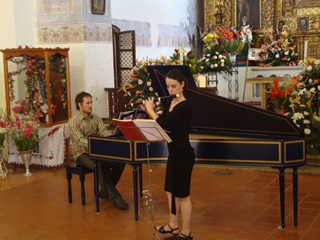 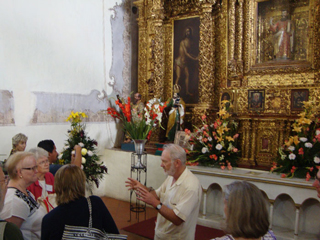
The 4´ table organ (1772), originally painted bright red, has been evaluated for a restoration, since it is nearly intact. We were refreshed by a drink of tejate, of pre-hispanic origin and a specialty of this community, followed by a delicious meal of mole amarillo in the atrium of the church.
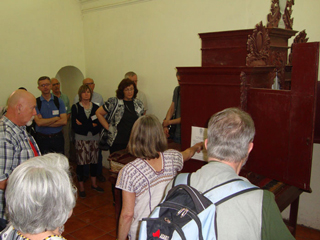 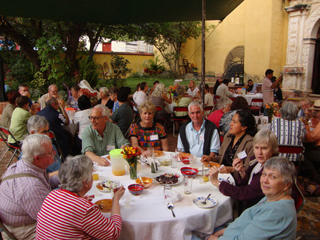
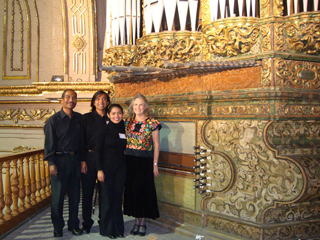
That night Cicely Winter presented the Third concert of the Festival in the Basílica de la Soledad, accompanied by Oaxacan percussionist Valentín Hernández. Joel Vásquez and Andrea Castellanos were indispensible in pulling the stops, since this music required many changes of registration. The huge church was packed and the crowd most enthusiastic, even singing along and swaying in time to a program of well-known Oaxacan folk music, played on a Oaxacan historical treasure. The case of this monumental 8´ organ is elaborately decorated and bears the earliest date of any Oaxacan organ: 1686. The interior components were rebuilt during the 18th century, and the organ was restored in 2000.

February 17 (Friday)
Participants could choose one of three options for the Friday morning activity: a visit to the archeological site of Monte Alban with Marcus Winter (INAH), the opportunity to play the organs in the Basilica of La Soledad and the Cathedral, or a guided tour by Richard Perry of the most beautiful colonial churches in Oaxaca City.
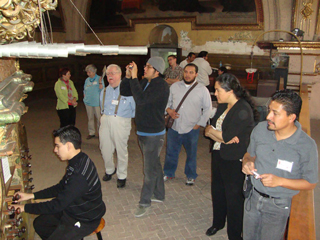 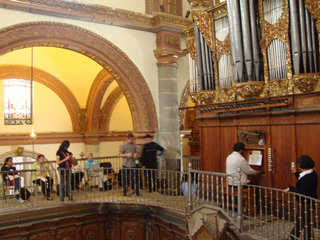
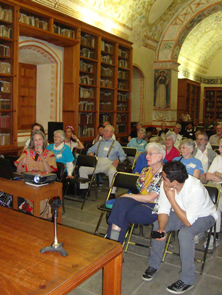
That afternoon, Cicely Winter presented a talk in the Francisco de Burgoa Library about “The Historic Organs of Oaxaca and the Work of the IOHIO”. Although the title of the talk does not change from year to year, the content does, and the images of the organs and of the various IOHIO projects spoke for themselves. The talk was followed by a spirited discussion among the organists and organbuilders about conservation and restoration issues.
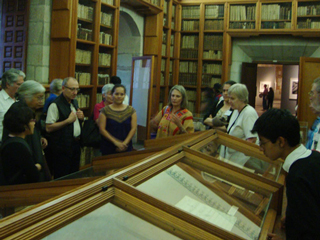
This was followed by an exhibit of documents related to music from various Oaxacan archives. Entitled “Musicógrafos y Melómanos”, the exhibit included 16th – 20th century printed documents and manuscripts from Europe, Mexico, and Oaxaca.
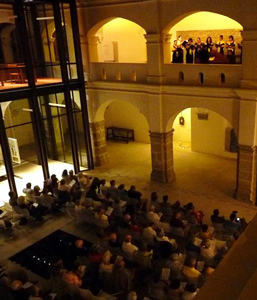
The Fourth concert of the Festival took place in the newly restored Centro Académico y Cultural San Pablo. The baroque ensemble “Melos Gloriae,” directed by Juan Manuel Lara, offered a captivating program of “Polyphonic Music Francisco López Capillas (1614-1674),” the most prolific Mexican composer of baroque masses. The acoustics were splendid as the choir sang from the second story of the former convent.
February 18 (Saturday)
Our caravan of seven vehicles journeyed through the mountainous Mixteca Alta region to Santa María de la Natividad Tamazulapan for the Fifth concert of the Festival. Organists Laura Carrasco and Elisa Freixo played charming pieces appropriate for this 2´ processional organ, situated in a high side balcony overlooking the huge nave of the church. They were joined by IOHIO organist Joel Vásquez and his young student Isaí Guzmán.
 
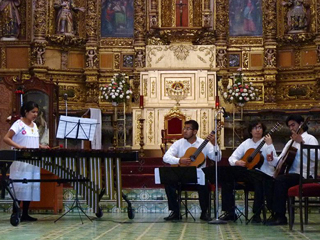
As in years past, we have featured music on other instruments to alternate with this small organ. Oaxacan percussionist Gabriela Edith Pérez Díaz and the “Terceto Cuicacalli” guitar ensemble from Mexico City (Diego Arias Ángel, Miguel Ángel Vences Guerrero, and Eduardo Rodríguez de la Torre) added variety to the program with pieces by J.S. Bach transcribed for marimba and by Vivaldi and more modern composers for guitars. Afterward we admired one of the most splendid altarpieces in Oaxaca, which includes paintings by the renowned 16th century Spanish painter Andrés de la Concha.
No matter how carefully we try to plan the schedule, there are always “surprises” beyond our control and this time it was the highway construction which detained us for an hour en route to Santo Domingo Yanhuitlan.
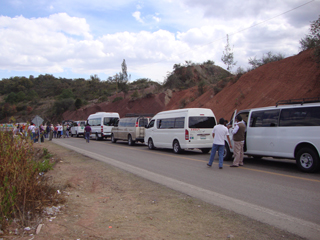 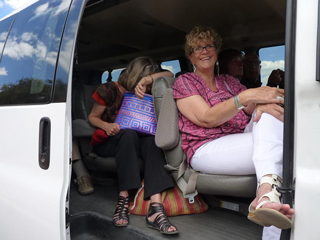
Luckily the Sixth concert of the Festival by the choral ensemble “Melos Gloriae” had just started when we finally arrived, and we were able to savor the program of “Sacred Music from the Museo Nacional del Virreinato” in the vaulted stone space of one of the most imposing 16th century buildings in the Americas. Organist Abraham Alvarado played a selection of French pieces to demonstrate the sound of the organ. Built around 1700 and restored in 1997, this magnificent 8' instrument is decorated in a style closely resembling that of La Soledad.
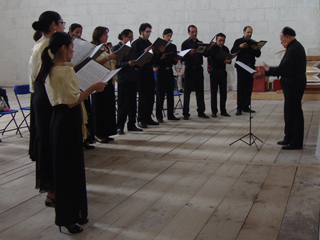 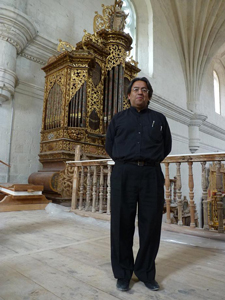
As in years past, the Federal Road and Bridge Commission (CAPUFE) opened an entrance from the super highway, allowing us direct access to San Andrés Zautla and saving us over an hour of travel time. The fiesta and concert in Zautla are always a highlight of the Festival. We were received in the atrium of the church by the local band with mezcal, necklaces of bugambilia, and dancing. We then followed the band to the patio behind the church for a sumptuous meal featuring estofado de pollo, a delicious Oaxacan stew.
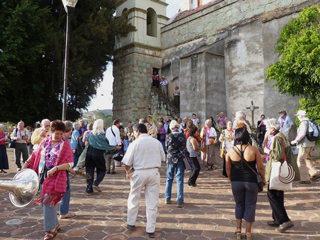 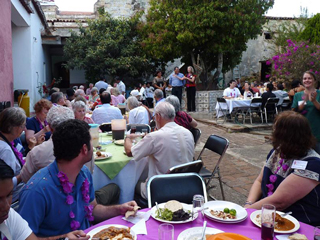
The Seventh concert of the Festival, presented by various Mexican musicians, took place in Zautla’s lovely baroque church. Organist Laura Carrasco played works from archive manuscripts in Morelia and Puebla, as well as a set of verses from the “Notebook of Psalm Tones of Sor María Clara del Santísimo Sacramento” (the 19th century Oaxacan nun who compiled the pieces in the notebook) from the Oaxaca Cathedral.
As in Tamazulapan, the organ alternated with the marimba (Gabriela Edith Pérez Díaz) and the guitar ensemble “Terceto Cuicacalli” (program). The concert was projected on a screen, which allowed the public to watch the action in the choir loft: the bellows pumped by hand and the registers controlled by lateral slider tabs.
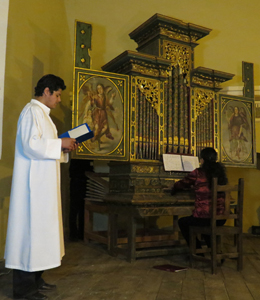 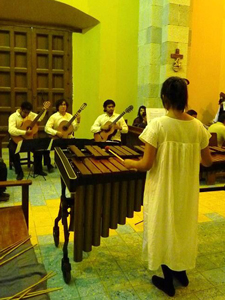
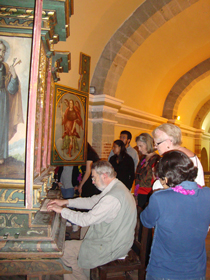
After the concert, interested local folks and visitors climbed up to the choir loft to hear an explanation of the organ’s history and construction and admire it up close. The case of this 4´ table organ (1726) is exquisitely painted with images of Saints Peter and Andrew and four archangels.
February 19 (Sunday)
Our first stop in our second Tlacolula Valley tour was Santa María de la Asunción Tlacolula. Once again we experienced the exciting moment of reaching the top of the winding stone staircase to see yet another unique instrument face to face in the choir loft. Dating presumably from the 18th century, this stately 8´ organ is nearly complete and has the most elaborately painted façade pipes in all Mexico. A proposal for its restoration by Gerhard Grenzing is being evaluated by the INAH in Mexico City. We also viewed the little 2´ 18th century processional organ, the smallest in Oaxaca, which was built for the baroque chapel of the Señor de Tlacolula, currently undergoing restoration.
 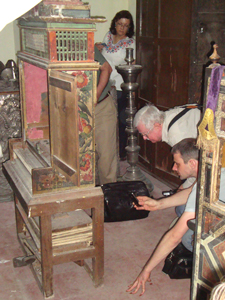
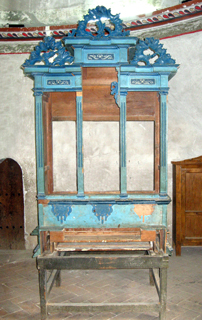
This year for the first time, we programmed a visit to the church of San Miguel del Valle, whose bell towers are decorated with glazed pottery dishes imbedded in the stucco. The 4´ table organ appears to date from around 1800 and has neo-classic design features. Even though the pipes and keyboard no longer exist, the organ still retains its windchest and original bellows.
 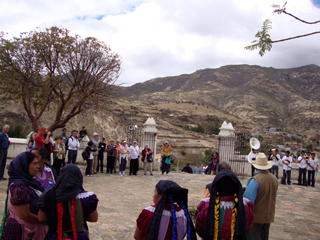
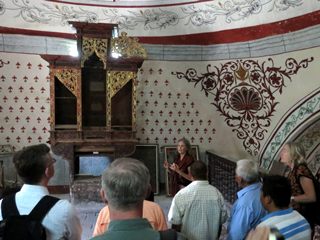 We then traveled to San Dionisio Ocotepec to view one of Oaxaca’s earliest and most important organs (the date 1721 appears on a label in the inside of the case). The lower case of this tall 4´ stationary instrument is narrower than the upper, an unusual design in earthquake-prone Oaxaca. The organ came close to being destroyed just around the time the IOHIO made its first visit in 2001. Its decorated doors had fallen off and were luckily retrieved, framed, and hung in the sacristy. The sacristans brought the former doors to the choir loft so that participants could see on one of them, King David playing his harp and the other, Santa Cecilia playing the Ocotepec organ, with the bellows behind and the original façade decoration. We then traveled to San Dionisio Ocotepec to view one of Oaxaca’s earliest and most important organs (the date 1721 appears on a label in the inside of the case). The lower case of this tall 4´ stationary instrument is narrower than the upper, an unusual design in earthquake-prone Oaxaca. The organ came close to being destroyed just around the time the IOHIO made its first visit in 2001. Its decorated doors had fallen off and were luckily retrieved, framed, and hung in the sacristy. The sacristans brought the former doors to the choir loft so that participants could see on one of them, King David playing his harp and the other, Santa Cecilia playing the Ocotepec organ, with the bellows behind and the original façade decoration.
Elisa Freixo presented the Eighth concert of the Festival in San Jerónimo Tlacochahuaya, which culminated the musical aspect of the festival. Her varied program highlighted the musical possibilities of the organ and projected rich sounds and tone colors rarely heard on this instrument. Built sometime before 1735 and restored in 1991, this is the most famous of the Oaxacan organs. The case and pipes are exquisitely decorated with floral motifs, and the organ harmonizes beautifully, both visually and acoustically, with the architecture of the church. As in some of the other churches, we projected the concert on a screen in the church. In this way people could see how the registers were changed and watch the organist's hands as she played..
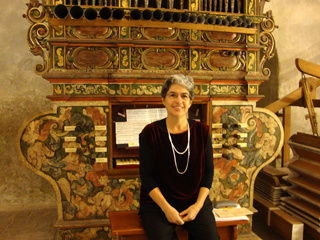 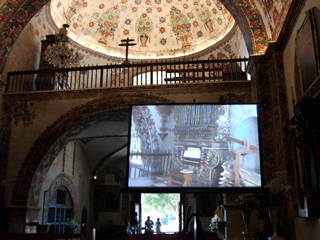
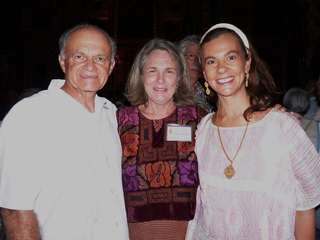 We were delighted to have with us at several of our festival concerts Don
Alfredo Harp Helú and his wife, María Isabel Grañen Porrúa, president of the We were delighted to have with us at several of our festival concerts Don
Alfredo Harp Helú and his wife, María Isabel Grañen Porrúa, president of the
Alfredo Harp Helú Foundation in Oaxaca (FAHHO). The IOHIO is honored
to be included among the many cultural projects of the Foundation and
especially appreciates Don Alfredo’s interest in supporting organ restoration
projects over the past years. These include five of the seven restorations in
Oaxaca (though Fomento Social and Fomento Cultural Banamex) and the
restorations of the two monumental organs in the Mexico City Cathedral (the
second of which is in process) in collaboration with the organbuilder Gerhard
Grenzing.
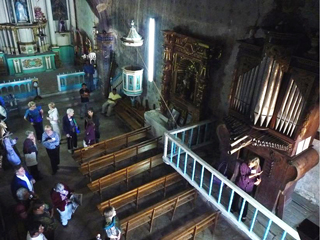
February 20 (Monday)
Our second all-day trip to the Mixteca Alta began with a visit to the unrestored organ in Santa María Tinú. The little stone church houses two baroque altarpieces and a disproportionately large organ (1828). Perhaps the organ was originally commissioned for a bigger church or perhaps the community simply wanted something grand. The organ, completely intact and played just a generation ago, still grunts and wheezes when the bellows located in the loft above are pumped.
Some years had passed since we last included a visit to the organ in San Andrés Sinaxtla in our festival tour, so it was of particular interest to our regular participants to see it for the first time. This instrument is neo-classic in design, richly carved but unpainted. Most unusual is the inscription across the façade of the organ including the date of construction (1791), the cost, and the name of the donor (a personal statement unthinkable a half century before).
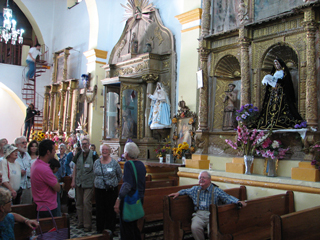 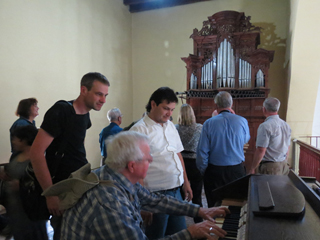
Just up the road from Sinaxtla, the community of San Mateo Yucucuí sits on a promontory overlooking the Yanhuitlán Valley. It is said that when this 8´ organ was played, it could be heard for miles around. The organ (1743) was never painted or gilded, probably because the parish ran out of money, but is richly carved and still has its original keyboard. The floor of the high balcony on which the organ sits is much deteriorated, but the custodian had laid down some planks so that participants could get a closer look at the organ.
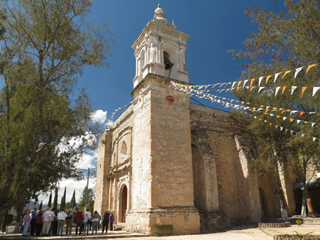 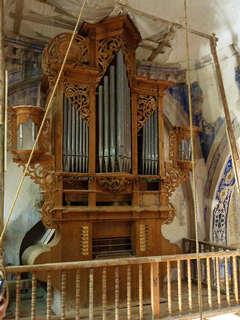
Because of the delay on Saturday due to highway construction, we decided to change our plan so as not to venture beyond Yanhuitlán and unfortunately had to eliminate the visits to Tejupan and Teotongo. Instead we returned to the church of Yanhuitlán, since there hadn’t been adequate time to appreciate the church art and architecture after Saturday’s choral concert. Although the church was closed that day, our friend the custodian opened it for us specially. This church is one of the jewels of 16th century architecture in all the Americas, and it was amazing to have this space all to ourselves.
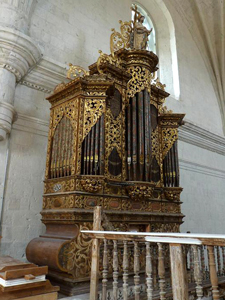 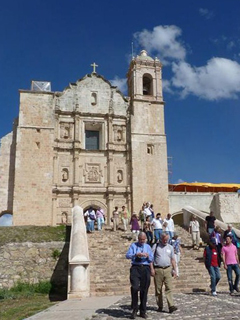
Our final church and organ visit was in Santa María Tiltepec, for some the crowning visual experience of the field trips. Built in the 16th century as an open chapel atop a prehispanic temple, the 17th century church has long been appreciated by art historians for its richly carved, asymmetrical façade. The organ is one of Oaxaca´s oldest (1703) and is unique in its technical design and colorful, whimsical carved (not painted) decoration.
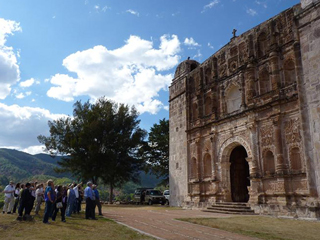 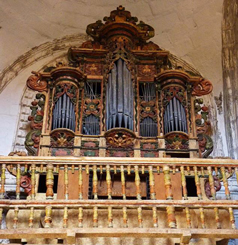
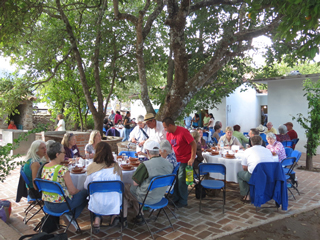
We then walked down the hill and across the river to the home of the Cruz Martínez family for our farewell dinner. We feasted on barbacoa de borrego, lamb barbecued Oaxacan style, cooked in the ground over hot rocks and covered with maguey leaves. Mezcal from San Bartolo Yautepec flowed freely, and everyone had one last chance to relax and enjoy the festival company before returning to Oaxaca.
**************************************************************
Participants in the Ninth Festival were enthralled by their Oaxaca experience, and the village authorities, who always received us with ceremony and respect, were equally pleased by our attention to the organs in their communities. It is clear that the promotion of the organs during our festivals is one more step toward guaranteeing their preservation.
The IOHIO has many pending projects between now and the Tenth Festival (tentatively planned for February 2014), including organ concerts in city and village churches, more CDs of festival concerts, a book about the Oaxacan organs, continuing documentation and conservation work, and at least one organ restoration. By the time we meet again, there will be a lot to celebrate!
|









































 We then traveled to San Dionisio Ocotepec to view one of Oaxaca’s earliest and most important organs (the date 1721 appears on a label in the inside of the case). The lower case of this tall 4´ stationary instrument is narrower than the upper, an unusual design in earthquake-prone Oaxaca. The organ came close to being destroyed just around the time the IOHIO made its first visit in 2001. Its decorated doors had fallen off and were luckily retrieved, framed, and hung in the sacristy. The sacristans brought the former doors to the choir loft so that participants could see on one of them, King David playing his harp and the other, Santa Cecilia playing the Ocotepec organ, with the bellows behind and the original façade decoration.
We then traveled to San Dionisio Ocotepec to view one of Oaxaca’s earliest and most important organs (the date 1721 appears on a label in the inside of the case). The lower case of this tall 4´ stationary instrument is narrower than the upper, an unusual design in earthquake-prone Oaxaca. The organ came close to being destroyed just around the time the IOHIO made its first visit in 2001. Its decorated doors had fallen off and were luckily retrieved, framed, and hung in the sacristy. The sacristans brought the former doors to the choir loft so that participants could see on one of them, King David playing his harp and the other, Santa Cecilia playing the Ocotepec organ, with the bellows behind and the original façade decoration.

 We were delighted to have with us at several of our festival concerts Don
Alfredo Harp Helú and his wife, María Isabel Grañen Porrúa, president of the
We were delighted to have with us at several of our festival concerts Don
Alfredo Harp Helú and his wife, María Isabel Grañen Porrúa, president of the








